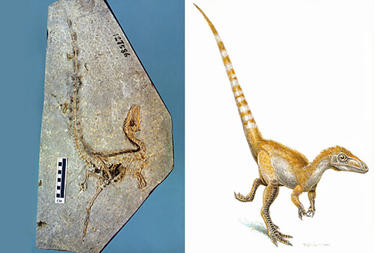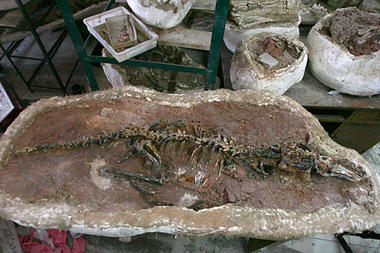| Location: Home > News > Events |
| Christian Science Monitor: New findings: dinosaurs were birds of a colored feather |
|
Two findings this week boost the link between birds and dinosaurs. They include the discovery of a bird-like dinosaur and a fossil analysis that suggests some dinosaurs sported colored feathers.


On the top, shows the fossil of a small flesh-eating Chinese theropod dinosaur Sinosauropteryx. On the bottom, shows a Sinosauropteryx, sporting its orange and white striped tail. (l.-r.) Nanjing Institute/AP, Jim Robins/University of Bristol/AP
The link between dinosaurs and birds – already tight – grew tighter still this week. Scientists say they have uncovered a bird-like dinosaur – a distant relative to the oldest known bird, Archaeopteryx. But it's millions of years older. Another team says it has identified coloring agents in fossilized feathers from ancient birds and non-avian theropod dinosaurs – a group that includes velociraptor and Tyrannosaurus rex. The coloring agents are similar to those in the feathers of modern birds. It appears many avian and non-avian dinosaurs may have sported their own versions of Joseph's Technicolor dream coat. The findings shed light on the evolutionary path from Barney's ancestors to barn swallows, as well as the path leading to modern feathers, researchers say. The findings collectively represent "additional evidence that birds really come from dinosaurs, and we're discovering more and more just how bird-like some of the dinosaurian precursors were," says Hans-Dieter Sues, associate director for collections and research at the Smithsonian Institution's National Museum of Natural History in Washington. Links between birds and dinosaurs
Case in point: Haplocheirus sollers, the bird-like dinosaur excavated in 2004 and described this week by a team of scientists from the George Washington University in Washington and the Institute of Vertebrate Paleontology and Paleoanthropology in Beijing. The fossil of Haplocheirus sollers is a nearly complete skeleton estimated to measure between 6 and 7-1/2 feet from nose to tail tip. It belongs to a broad group of theropods known as Alvarezsauriods. When the first Alvarezsauroids came to light in the 1990s, their bird-like traits prompted researchers to categorize them among prehistoric birds or very close to them on the family tree, says Thomas Holtz Jr., a paleontologist at the University of Maryland in College Park. But to some, that posed a kind of parent-younger-than-child conundrum. The first Alvarezsaroid fossils discovered dated to the Cretaceous Period; the first fossil birds appeared much farther back in time, during the Jurassic. In effect, that would mean the first bird-like dinosaurs – supposedly the ancestors of birds – were appearing in the fossil record well after the first bird appeared. Along comes Haplocheirus. Aged between 158 million and 162 million years old, it pushes the fossil record for Alvarezsauroids back by some 63 million years, well back into the Jurassic. Haplocheirus is thus probably a primitive, distant relative to the line of dinosaurs from which birds evolved, says the team that discovered it. That erases the apparent paradox, Dr. Sues says, and represents an interesting case of convergent evolution, in which two widely separated groups on the dinosaur family tree independently develop many similar skeletal traits. A theropod with a orange-and-white tail
The discovery of coloring agents in dinosaur feathers is also astonishing, paleontologists say. A team led by Chinese paleontologist Fucheng Zhang analyzed feathers found in fossils of early birds and other theropods that lived during the early Cretaceous. They found tiny color-bearing features called melanosomes, which also appear in the plumage of modern birds and give them their distinctive colors. The team was able to determine that the bird they studied, Confuciusornis, had white, black, and russet plumage. What about non-avian theropods? They sport feather-like filaments, but some have argued that the filaments evolved to strengthen an animal's skin, not cover it with primitive form of plumage. But the team’s findings, reported in the latest issue of Nature, suggest that the filaments are in fact feathers. The team examined specimens of a theropod called Sinosauropteryx. "In every case where there are feathers preserved in the fossil and where we've looked, we find melanosomes," says Michael Benton, a paleontologist at Bristol University in the UK and a member of the team. He adds that the finds may help resolve the mystery behind the origin of feathers. Some have argued that they originated to help keep animals warm and emerged as part of the evolution of flight. In Sinosauropteryx's case, the melanosomes suggest it had alternating rings of orange and white along its tail. "The discoveries open up a whole new area of research, allowing us to explore aspects of the life and behavior of dinosaurs and early birds that lived over 100 million years ago," Dr. Benton says. From http://www.csmonitor.com/Science/2010/0128/New-findings-dinosaurs-were-birds-of-a-colored-feather |